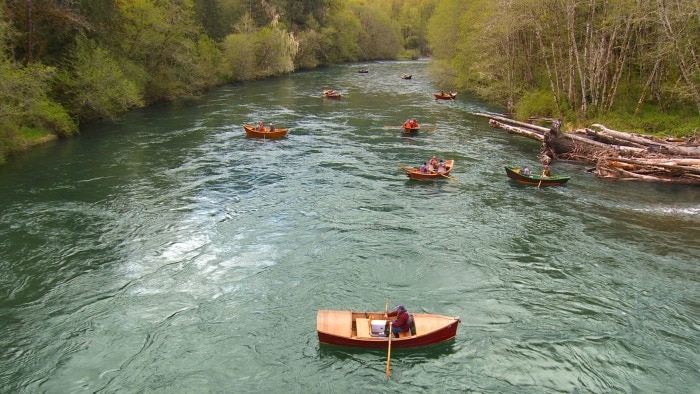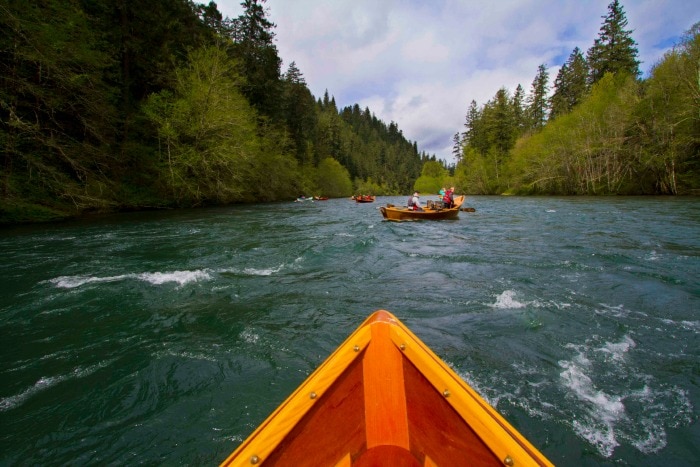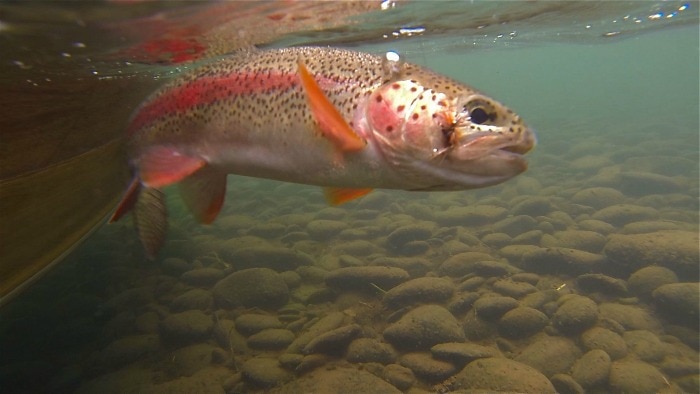You can tell a lot about a “community’s pride” by the parades they put on. Each spring on the McKenzie River, there is a dandy and all of it is handmade! Folks from all over the country gather to parade down the McKenzie River in drift boats. It’s a chance to connect with old friends and revisit history; a time when wooden drift boats ruled Oregon’s rivers.
Boat historian Roger Fletcher said, “These boats were specifically designed for running whitewater and they make wonderful fishing platforms too because they are safe and stable. Oregon is the spawning ground for this very unique drift boat.”
Fletcher’s right — Oregon’s early fishing guides figured out that in order to get their clients to the best fishing, they had to design a boat that would fill the bill for safety and stability.
Aaron Helfrich, a third generation fishing guide, said that the McKenzie River Drift Boat was born in the 1930s and continues to do the job. “Many Oregon rivers had been unexplored at that time and fellows like my grandfather Prince Helfrich, and boat builder Woody Hindman, came up with a design that was much more nimble than previous boats. They traveled into Canada and Idaho and boated down many of their rivers for the first time too.”
The parade of drift boats lead to the McKenzie River Wooden Boat Festival and is held below towering Eagle Rock at the popular Eagle Rock Lodge. Lodge owner and event host Randy Dersham welcomes everyone with open arms. “This is a total community event! I set the date. I make a poster and I let people know what’s going to happen – they show up and do their thing.”
Nearly forty wooden drift boats are on display at the festival, some gleaming with a newness that hasn’t been rubbed off by time and use, others rugged and worn from countless river adventures.
One particular drift boat dates to the 1930s and was recently restored by Wyoming boat builder Adam “Dutch” Gottschling. “It’s called “The Trapper,” noted Gottschling. “It was built in 1939 by Woody Hindman for local guide Prince Helfrich. Every boat at this festival evolved from this particular boat, and it’s completely original.”
Prince’s grandson, Aaron Helfrich, said that 80 years later, drift boating continues to provide the same function to help fishermen catch big fish. “The old theory still holds true: match the hatch! Whatever you see flying around, tie something on that looks like it.”
Aaron Helfrich has caught both hatchery and wild fish throughout the McKenzie River’s 63 fishable miles that stretch from the Cascade Mountains to the Willamette Valley. This day’s hatch was all about the caddis, and he offered several hand-tied dry fly creations with a highly visible “parachute.” Aaron said it’s a feature that’s key to the fly’s success. “The parachute on top makes the fly very visible because if you can’t see your dry fly on the water, you’re not fishing. You need to see the fish take that fly and keep it in his mouth for just a couple seconds, so you only have a couple seconds to set the hook in his lip.”
Under Aaron’s guidance, I cast the caddis across a riffle, lifted the fly rod and let the caddis fly drift with the current. Suddenly, a gorgeous trout slurped it down. I set the hook and the trout burst through the surface.
“That was a great take and that is one nice redside,” noted Helfrich. “That is the fish that made the McKenzie famous! When these native trout get to be 13 or 14 inches long, they develop a broad red band across their entire length. They have a lot of spirit when you catch them on a dry fly.”
It’s a “spirit” that can also be measured by Aaron’s family ties to the McKenzie River; he noted that 2014 marks 100 years of the Helfrich family guiding on the river. “There are now 15 Helfrich family members: brothers, sons, nieces, nephews and cousins – that guide across Oregon rivers. Most of them use the same style of drift boat that was made famous by my grandfather, Prince Helfrich.”
I asked Aaron how his grandfather would feel about his legacy. “I’ll bet my grandfather had no idea what he was starting so many decades ago,” noted Aaron with a smile. “But it really is a great office to work in. If you have the opportunity to do it, it’s hard to do anything else. I think that’s how he felt too.”



